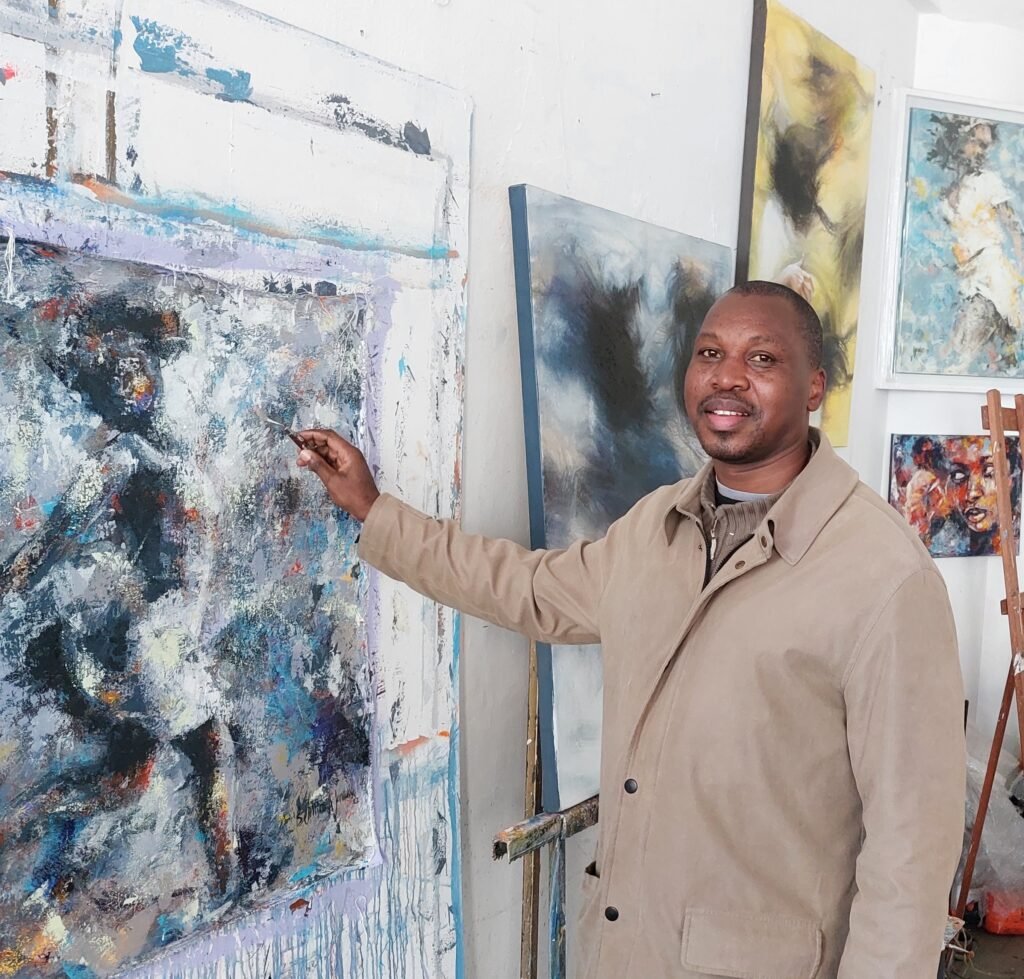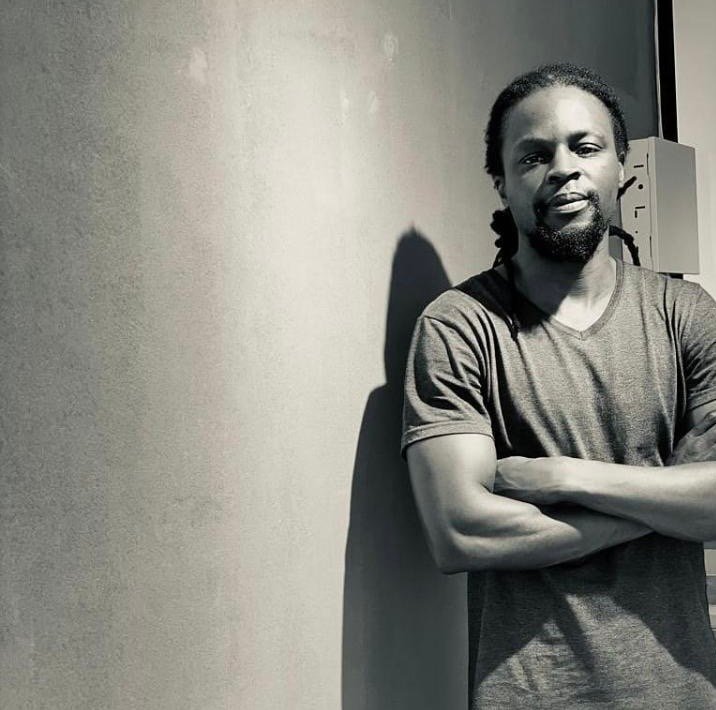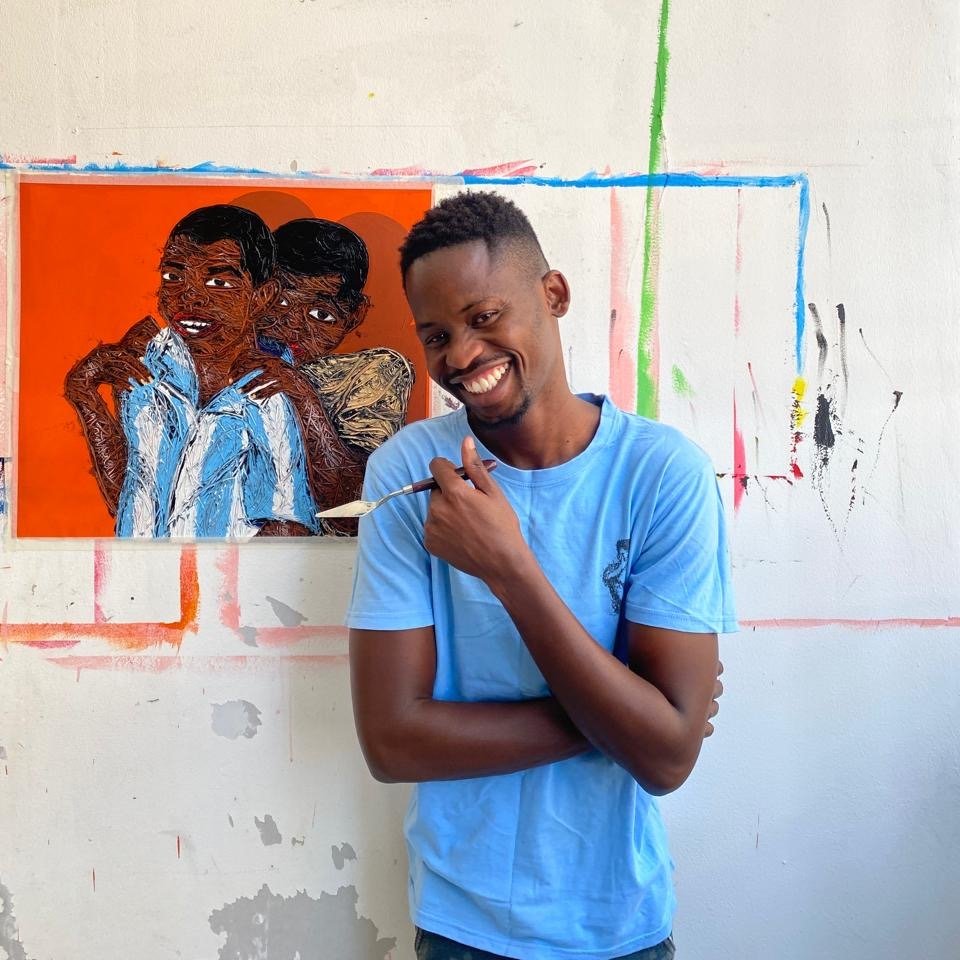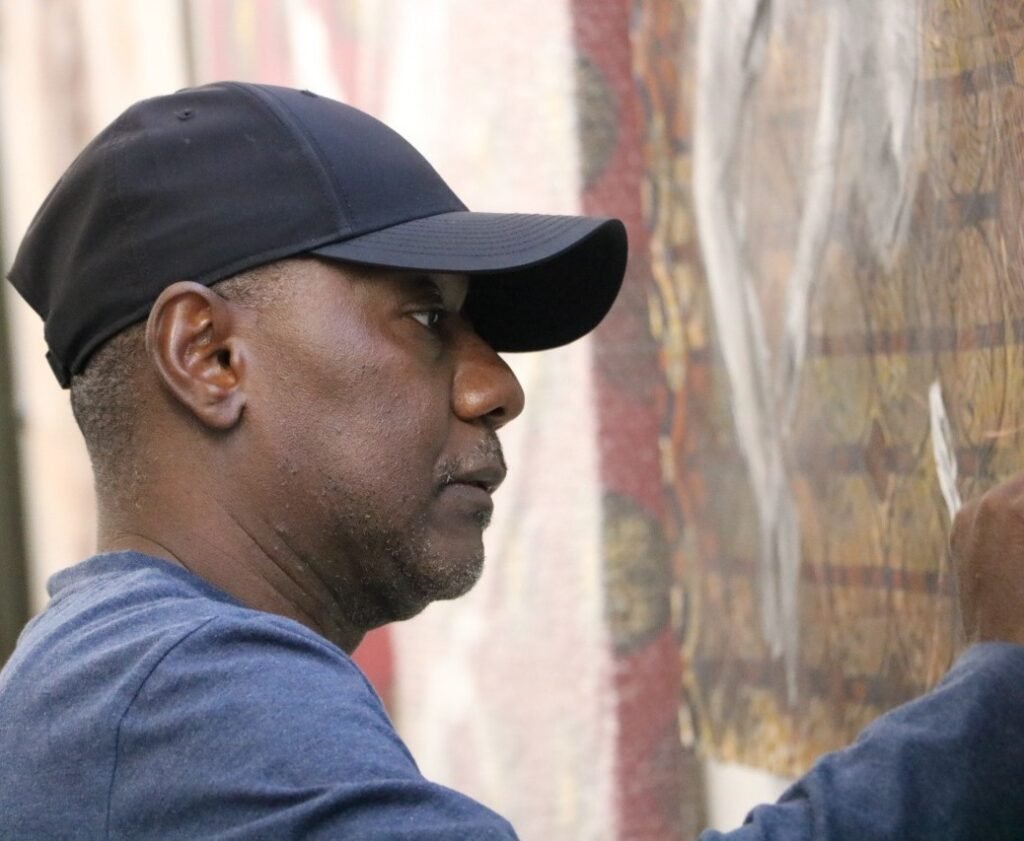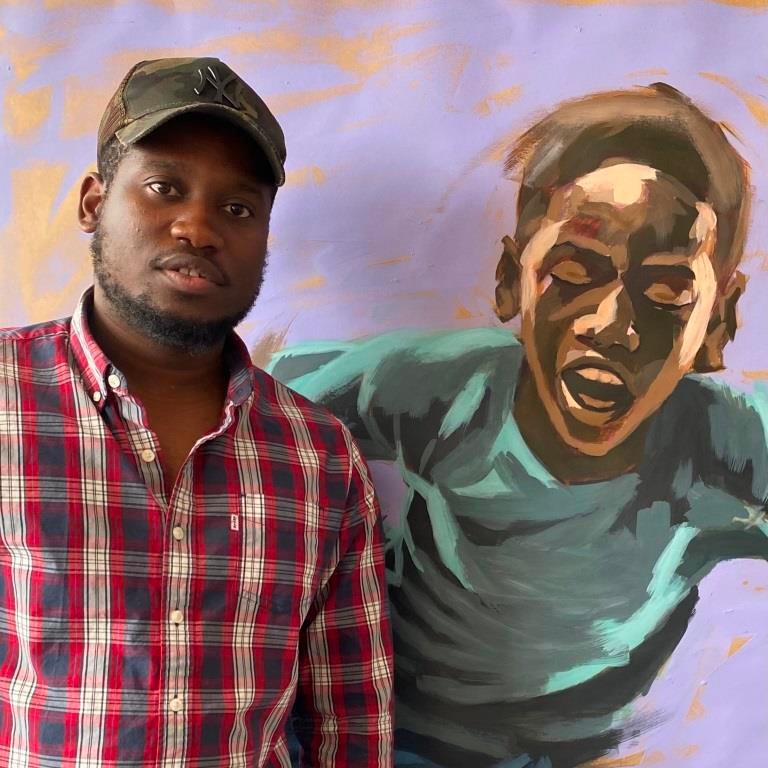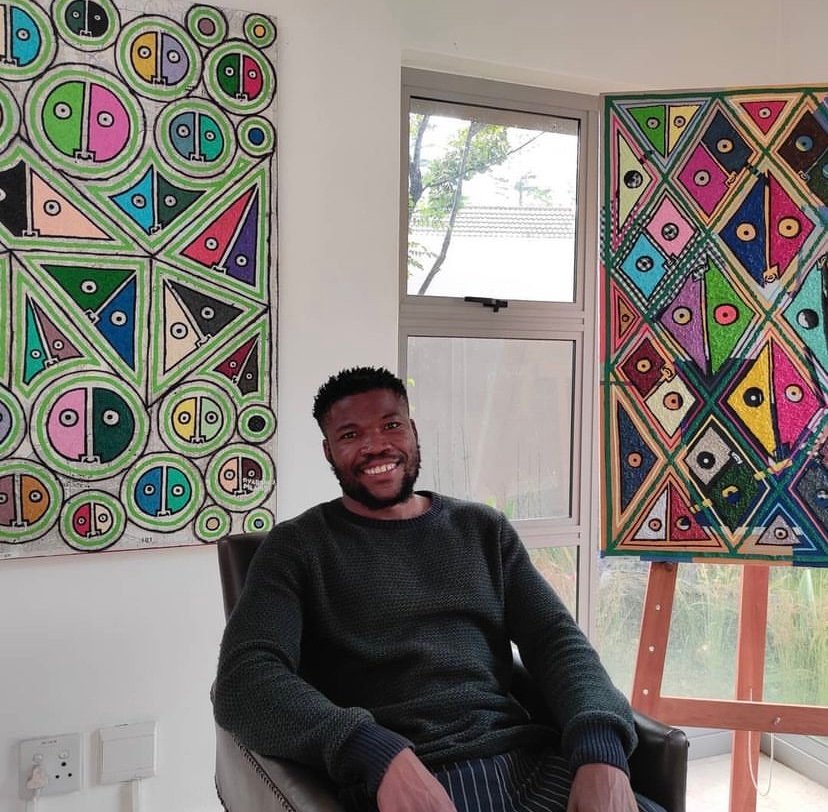
Siyabonga Mlambi
On Auction
Introduction
Siyabonga Mlambi is a talented contemporary artist hailing from Bizana in the Eastern Cape, South Africa. His creative journey began at an early age when, as a young boy, he experimented with clay, an experience that sparked a lifelong love for art. Over the past seven years, Mlambi has honed his artistic skills, fusing elements of traditional African heritage with contemporary artistic practices. His work is deeply rooted in the cultural richness of his upbringing, and he draws inspiration from both historical African art forms and modern artistic movements. Mlambi’s style is an eclectic blend of geometric abstraction, vibrant colors, and the repurposing of found objects, which he transforms into powerful symbols of identity, culture, and the intersection of past and present. Through his use of geometric patterns, he not only tells the story of his own background but also celebrates the broader African cultural narrative.
Early Life and Artistic Development
Siyabonga Mlambi’s early experiences with art were shaped by the natural world and cultural practices of his hometown in Bizana, a small town in the Eastern Cape. Growing up, Mlambi spent much of his time playing with clay, a material that became a central part of his artistic practice. His connection with the tactile nature of clay deepened over time, and it was here that the seeds of his artistic passion were first planted. The Eastern Cape, rich in cultural heritage and steeped in the traditions of rural South Africa, has undoubtedly shaped Mlambi’s worldview and continues to influence his work.
As his interest in art developed, Mlambi pursued formal education in KwaZulu-Natal, where he trained as a painter. His time in KwaZulu-Natal allowed him to engage with contemporary art, refine his skills, and broaden his understanding of art history. It was here that he encountered the works of iconic South African artists like Esther Mahlangu and Paul du Toit, whose influence would come to play a pivotal role in his artistic development.
Artistic Influences
Mlambi’s work draws heavily from the legacy of Esther Mahlangu, the renowned Ndebele artist, and Paul du Toit, a prominent South African colorist and abstract painter. Mahlangu’s iconic use of vibrant, geometric patterns in her Ndebele-inspired paintings and murals has profoundly impacted Mlambi’s aesthetic. Mahlangu’s use of color and form not only tells the story of the Ndebele people but also serves as a celebration of African identity. Much like Mahlangu, Mlambi uses geometric shapes as a visual language to tell the story of his own background, incorporating symbolic meaning into his patterns.
The influence of Paul du Toit, known for his abstract compositions and brilliant color combinations, also plays a significant role in Mlambi’s artistic practice. Du Toit’s work challenges traditional perceptions of color and form, often creating dynamic and visually striking works that invoke deep emotional responses. Mlambi’s use of color is equally bold and expressive, contributing to his paintings’ powerful impact. His use of abstraction, while grounded in cultural traditions, also connects with the modernist tradition of exploring new forms and expressions.
In addition to Mahlangu and du Toit, Mlambi is also inspired by artists like Willie Bester and Pat Mautloa, who have used found objects as a primary medium in their work. The practice of incorporating found objects into artworks has its roots in the Dada and Arte Povera movements, both of which sought to break down traditional boundaries between art and everyday life. For Mlambi, the found object is not merely a form of recycling but a starting point for artistic creation, imbued with meaning and potential. Like Bester and Mautloa, he uses discarded materials to create artworks that are both visually arresting and conceptually rich.
Techniques and Materials
Mlambi’s artistic practice is multi-faceted, incorporating both traditional and contemporary methods. One of his most distinctive features is his use of found objects, which he repurposes into figures and symbols. These objects—often everyday items or discarded materials—are transformed through the artist’s vision and become integral to the themes of his work. The found object serves as a metaphor for cultural identity, with each object representing something larger than itself. By painting over or adding to these objects, Mlambi imbues them with new meanings, often creating visual narratives that reflect his own personal experiences and his broader cultural context.
The use of geometric shapes is another hallmark of Mlambi’s style. Drawing inspiration from Esther Mahlangu’s Ndebele patterns, Mlambi incorporates sharp lines, triangles, diamonds, and squares into his works. These shapes are not merely decorative but serve as a visual language that communicates a deeper narrative. For Mlambi, geometric patterns are a way of telling the story of his own background—his Eastern Cape heritage, his journey as an artist, and his connection to the broader African cultural narrative.
In his abstract paintings, Mlambi employs a vibrant palette of colors, drawing upon the energy and dynamism that characterize his practice. The multi-colored surfaces of his paintings create a sense of rhythm and movement, often reminiscent of the improvisational nature of jazz music, a genre that Mlambi loves and listens to frequently. The use of color is not arbitrary; each hue carries emotional and cultural significance. The vibrant tones that Mlambi selects reflect the joy, vibrancy, and resilience of African culture, while the abstract nature of his work allows for a more personal and subjective interpretation.
In some of his pieces, Mlambi adds objects or subtle shadows to the canvas, further enriching the visual complexity of his work. These additions create a sense of depth, inviting the viewer to look closer and engage more deeply with the themes of the painting. The objects and shadows add an element of surprise and intrigue, encouraging the viewer to uncover the layered meanings embedded in each piece.
Themes and Artistic Philosophy
At the heart of Siyabonga Mlambi’s work is a celebration of African culture and heritage. His paintings, often vibrant and abstract, explore themes of identity, tradition, and transformation. Through the use of geometric shapes, color, and found objects, Mlambi tells a story that is both personal and universal. His work speaks to the importance of cultural pride, the resilience of African communities, and the power of art to convey meaning beyond the visual.
Mlambi’s interest in found objects highlights his philosophical belief in the potential of everyday materials to become something greater than themselves. Much like the Dada and Arte Povera movements that sought to elevate the ordinary, Mlambi uses found objects to create works of art that are infused with meaning. These objects—whether they are pieces of wood, metal, fabric, or discarded materials—become symbols of transformation and continuity. They carry within them the history of their original use and are reborn through the artist’s vision.
The use of jazz music in Mlambi’s life and work further enriches his creative process. Jazz, with its improvisational nature and focus on freedom of expression, parallels the fluidity and spontaneity in Mlambi’s artistic practice. He often listens to jazz as he works, allowing the rhythm and mood of the music to inform the energy and direction of his paintings. Just as jazz musicians build on themes and motifs in unpredictable ways, Mlambi’s art evolves, guided by the influence of his materials, his cultural heritage, and his own emotional response to the world around him.
Conclusion
Siyabonga Mlambi is an artist whose work reflects a deep engagement with both his cultural heritage and the contemporary world. His practice, influenced by the works of Esther Mahlangu, Paul du Toit, and other African artists like Willie Bester and Pat Mautloa, demonstrates a unique synthesis of traditional African aesthetics and modern artistic sensibilities. Through the use of geometric patterns, vibrant colors, and found objects, Mlambi tells a powerful and personal story of identity, culture, and transformation. His work is a testament to the resilience of African art and culture, as well as to the ability of the artist to adapt, innovate, and reimagine the world through their creative vision.
By incorporating abstract forms and materials that resonate with cultural meaning, Siyabonga Mlambi continues to build a body of work that speaks to the ongoing evolution of African identity in a rapidly changing world. His paintings are not only a reflection of his own journey but also an invitation for others to engage with the stories and histories that shape us all.

